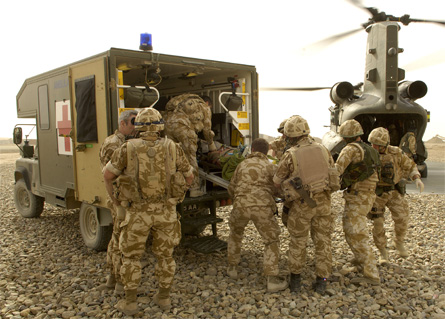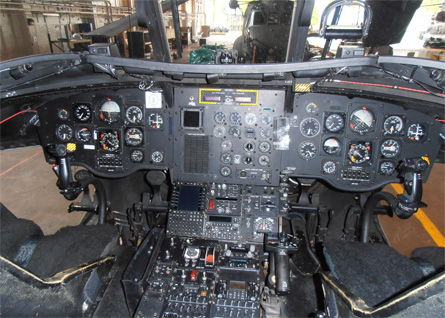The UK Royal Air Force has launched activities to commemorate 30 years of operational service with its Boeing CH-47 Chinook transport helicopters, while roughly one-quarter of its fleet remains committed to the NATO-led campaign in Afghanistan.
Delivered from 1980, several of the RAF's then HC1-standard aircraft were assigned to support British troops during the Falklands War with Argentina in 1982. All but one were destroyed when two Exocet anti-ship missiles hit the container ship Atlantic Conveyer.
UK Chinooks have since seen operational duty around the globe, from taking part in combat operations in Afghanistan and Iraq - and a military intervention in Sierra Leone - to supporting peacekeeping activities in the Balkans and flying earthquake-relief missions in Pakistan.
Several also evacuated British nationals from Lebanon in 2006 after arriving within 20h of a request being made.
|
|---|
© BoeingThe RAF is displaying the Chinook with a special livery at air shows around the UK as the type enters its 30th year of service |
"For 29 years the Chinook force has never had a period of recuperation - it has been on operations permanently," says Gp Capt Steve Shell, Chinook force commander and station commander at the type's main operating base, RAF Odiham in Hampshire. "We're pretty good at getting into places very quickly. We're not so good at getting out as quickly," he adds.
Although the RAF is required to be able to conduct operations under freezing, desert and mountain conditions or from ships at sea, the main duty for the Chinook force during the past few years has been to transport personnel, equipment and supplies in Afghanistan.
"The whole base is optimised for the war," says Shell, who describes the UK's Operation "Herrick" commitment as the Chinook's biggest challenge since entering RAF service.
"Now we have Afghanistan, Afghanistan and Afghanistan - it can get tedious," he says, noting that some personnel are approaching their tenth deployment to the country.
The UK has 11 of its 46 Chinooks on detachment in Afghanistan, operated by flights of about eight air crews.
 |
|---|
© S Sgt Mark Jones/Crown Copyright |
Roughly 25% of its remaining aircraft are in maintenance or upgrade and the rest are on the line at Odiham. Of the latter, about 75% are available to fly each day, with one aircraft and one crew held at 2h readiness to respond to national contingencies. Up to four aircraft and crews can be deployed overseas within roughly two days.
The Afghan mission has radically changed the way in which the UK tasks its Chinooks. Each pilot can expect to log about 250 flight hours a year, but roughly 150 of these will come during a three-month stint at Camp Bastion and Kandahar airfield.
The force is now divided into five blocks of personnel, which Shell says provides a clear plan of their commitments and allows them to spend more time with their families.
Prior to deploying, crews undergo environmental training in locations ranging from Kenya and Morocco to Jordan and the USA. This is intended to replicate the conditions which will be encountered in Afghanistan, although Shell says its dust clouds can be "ten times the size, density and complexity".
The Taliban's recent downing of a US Army MH-47 Chinook has highlighted the continued vulnerability of low- and slow-flying helicopters against small-arms fire, heavy-calibre weapons and rocket-propelled grenades. Thirty US and eight Afghan military personnel were killed in the incident.
"We have the best defended and the best armoured helicopter in the sky," Shell says. "You can keep strapping on every new idea that the scientists have. They are now the right aircraft to put deliberately in harm's way."
The type's survivability has been demonstrated several times by RAF crews, with their aircraft having been recovered after sustaining serious damage from ground fire. In their most dangerous duty, Chinooks provide an immediate response team (IRT) capability to swiftly evacuate injured personnel, getting airborne within an average of 6min. They carry about 20 specialist personnel, including doctors and nurses, plus explosive-ordnance-device and force-protection specialists to safeguard the aircraft while on the ground. Typically, three such missions are flown by the RAF every day which had, by mid-July, lifted more than 1,980 casualties. US helicopters provide additional cover. "The IRT has grown to become Chinook-sized, because of the armour that's now available and the aggression with which you need to fight your way in," says Shell. "It won't go into another platform."
 |
|---|
© POA(Phot) Sean Clee/Crown Copyright |
RAF Chinooks are launched around three times per day in Afghanistan to evacuate casualties |
Despite frontline demands, a fleet-wide upgrade is under way to enhance the Chinook's capabilities so it remains viable until at least 2040. As with the programme which brought HC1-standard helicopters to the HC2 mark in the mid-1990s, the project must not disrupt the force's ability to meet operational commitments. With the RAF's current aircraft representing 17 different modification states, Shell says a key aim is to provide coherence. Variances are primarily found in communications equipment, and where urgent operational requirement activities have been performed to support some aircraft in Afghanistan. Project Julius covers 38 Chinook HC2s and eight extended-range HC3s. Modified as HC4s, these will have Honeywell T55-714 engines and glass cockpit avionics, which Shell describes as a vital advance.
 |
|---|
© Craig Hoyle/Flightglobal |
The Chinook HC2's analogue cockpit equipment will be replaced through the Project Julius upgrade |
The first few HC4s are undergoing flight test in Havant, Hampshire, and at the Ministry of Defence's Boscombe Down site in Wiltshire. They will begin to be returned to the operational fleet before year-end, and go on to serve in Afghanistan.
Fourteen more Chinooks are also to be acquired, including replacements for two lost in non-fatal accidents in Afghanistan. To be designated HC6s, these will feature a high degree of commonality with Project Julius aircraft. The MoD is currently "working towards the main investment decision on these helicopters", with funding recently secured.
Referring to the cuts introduced via the UK's Strategic Defence and Security Review, Shell says: "We are probably the only place in the UK that has such an up-arrow."
Acquiring the additional transports should enable the RAF to meet a target to fly 21,000h a year with its Chinooks, with the force on target to log 18,500h in 2011. It will also require the UK to increase staffing levels from 66 crews to 86. "We will go back to being a force capable of going anywhere," says Shell.
"Every time a new crisis occurs the Chinook is called for. So as our prime minister is telling us that we're coming out of Afghanistan in 2015, what I'm wondering is, where we'll be next?"
Source: Flight International




















